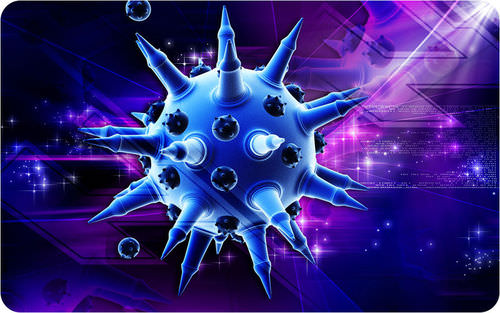7.16: Viruses
- Page ID
- 12183

What is a virus? Is it even a living organism?
This alien-looking thing is a virus. But is it prokaryotic or eukaryotic? Or neither? Or both? A virus is essentially genetic material surrounded by protein. That's it. So, is a virus prokaryotic or eukaryotic? Or neither? Or both?
Viruses: Prokaryotes or Eukaryotes?
Viruses, like the one depicted in Figure below, are tiny particles that may cause disease. Human diseases caused by viruses include the common cold and flu. Do you think viruses are prokaryotes or eukaryotes? The answer may surprise you. Viruses are not cells at all, so they are neither prokaryotes nor eukaryotes.
 Cartoon of a flu virus. The flu virus is a tiny particle that may cause illness in humans. What is a virus? Is it a cell? Is it even alive?
Cartoon of a flu virus. The flu virus is a tiny particle that may cause illness in humans. What is a virus? Is it a cell? Is it even alive?Viruses contain DNA but not much else. They lack the other parts shared by all cells, including a plasma membrane, cytoplasm, and ribosomes. Therefore, viruses are not cells, but are they alive? All living things not only have cells; they are also capable of reproduction. Viruses cannot reproduce by themselves. Instead, they infect living hosts, and use the hosts’ cells to make copies of their own DNA. Viruses also do not have their own metabolism or maintain homeostasis. For these reasons, most scientists do not consider viruses to be living things.
Further Reading
Summary
- Viruses are neither prokaryotic or eukaryotic.
- Viruses are not made of cells. Viruses cannot replicate on their own.
- Most scientists do not consider viruses to be living.
Review
- What is a virus?
- Explain why viruses are not considered to be living.
- Is a virus made of cells?
- Can a virus reproduce?
- Does a virus metabolize?
| Image | Reference | Attributions |
 |
[Figure 1] | Credit: Image copyright Kannanimages, 2014;Mariana Ruiz Villarreal (User:LadyofHats/Wikimedia Commons) Source: http://www.shutterstock.com ; commons.wikimedia.org/wiki/File:Animal_cell_structure_en.svg License: Used under license from Shutterstock.com;Public Domain |
 |
[Figure 2] | Credit: Image copyright Kannanimages, 2014;Mariana Ruiz Villarreal (User:LadyofHats/Wikimedia Commons) Source: http://www.shutterstock.com ; commons.wikimedia.org/wiki/File:Animal_cell_structure_en.svg License: Used under license from Shutterstock.com;Public Domain |

